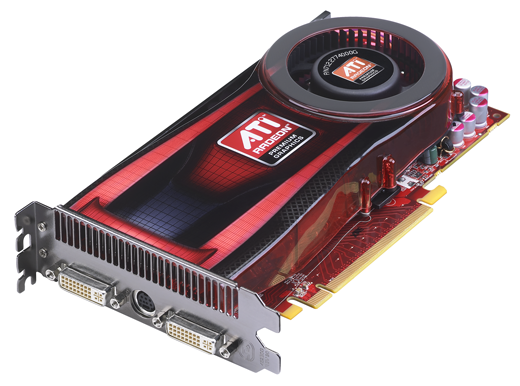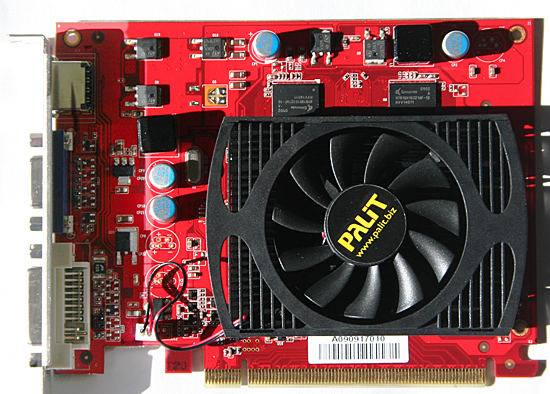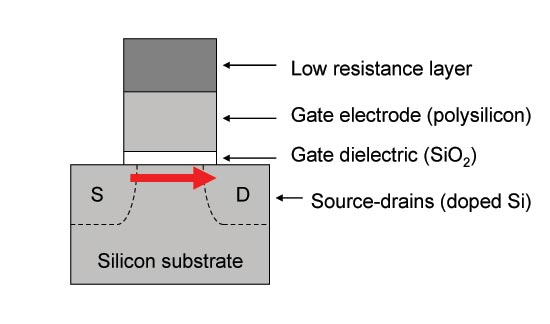The RV870 Story: AMD Showing up to the Fight
by Anand Lal Shimpi on February 14, 2010 12:00 AM EST- Posted in
- GPUs
The Payoff: How RV740 Saved Cypress
For its first 40nm GPU, ATI chose the biggest die that made sense in its roadmap. That was the RV740 (Radeon HD 4770):

The first to 40nm - The ATI Radeon HD 4770, April 2009
NVIDIA however picked a smaller die. While the RV740 was a 137mm2 GPU, NVIDIA’s first 40nm parts were the G210 and GT220 which measured 57mm2 and 100mm2. The G210 and GT220 were OEM-only for the first months of their life, and I’m guessing the G210 made up a good percentage of those orders. Note that it wasn’t until the release of the GeForce GT 240 that NVIDIA made a 40nm die equal in size to the RV740. The GT 240 came out in November 2009, while the Radeon HD 4770 (RV740) debuted in April 2009 - 7 months earlier.

NVIDIA's first 40nm GPUs shipped in July 2009
When it came time for both ATI and NVIDIA to move their high performance GPUs to 40nm, ATI had more experience and exposure to the big die problems with TSMC’s process.
David Wang, ATI’s VP of Graphics Engineering at the time, had concerns about TSMC’s 40nm process that he voiced to Carrell early on in the RV740 design process. David was worried that the metal handling in the fabrication process might lead to via quality issues. Vias are tiny connections between the different metal layers on a chip, and the thinking was that the via failure rate at 40nm was high enough to impact the yield of the process. Even if the vias wouldn’t fail completely, the quality of the via would degrade the signal going through the via.
The second cause for concern with TSMC’s 40nm process was about variation in transistor dimensions. There are thousands of dimensions in semiconductor design that you have to worry about. And as with any sort of manufacturing, there’s variance in many if not all of those dimensions from chip to chip. David was particularly worried about manufacturing variation in transistor channel length. He was worried that the tolerances ATI were given might not be met.

A standard CMOS transistor. Its dimensions are usually known to fairly tight tolerances.
TSMC led ATI to believe that the variation in channel length was going to be relatively small. Carrell and crew were nervous, but there’s nothing that could be done.
The problem with vias was easy (but costly) to get around. David Wang decided to double up on vias with the RV740. At any point in the design where there was a via that connected two metal layers, the RV740 called for two. It made the chip bigger, but it’s better than having chips that wouldn’t work. The issue of channel length variation however, had no immediate solution - it was a worry of theirs, but perhaps an irrational fear.
TSMC went off to fab the initial RV740s. When the chips came back, they were running hotter than ATI expected them to run. They were also leaking more current than ATI expected.
Engineering went to work, tearing the chips apart, looking at them one by one. It didn’t take long to figure out that transistor channel length varied much more than the initial tolerance specs. If you get a certain degree of channel length variance some parts will run slower than expected, while others would leak tons of current.
Engineering eventually figured a way to fix most of the leakage problem through some changes to the RV740 design. The performance was still a problem and the RV740 was mostly lost as a product because of the length of time it took to fix all of this stuff. But it served a much larger role within ATI. It was the pipe cleaner product that paved the way for Cypress and the rest of the Evergreen line.
As for how all of this applies to NVIDIA, it’s impossible to say for sure. But the rumors all seem to support that NVIDIA simply didn’t have the 40nm experience that ATI did. Last December NVIDIA spoke out against TSMC and called for nearly zero via defects.
The rumors surrounding Fermi also point at the same problems ATI encountered with the RV740. Low yields, the chips run hotter than expected, and the clock speeds are lower than their original targets. Granted we haven’t seen any GF100s ship yet, so we don’t know any of it for sure.
When I asked why it was so late with Fermi/GF100, NVIDIA pointed to parts of the architecture - not manufacturing. Of course, I was talking to an architect at the time. If Fermi/GF100 was indeed NVIDIA’s learning experience for TSMC’s 40nm I’d expect that its successor would go much smoother.
It’s not that TSMC doesn’t know how to run a foundry, but perhaps the company made a bigger jump than it should have with the move to 40nm:
| Process | 150nm | 130nm | 110nm | 90nm | 80nm | 65nm | 55nm | 40nm |
| Linear Scaling | - | 0.866 | 0.846 | 0.818 | 0.888 | 0.812 | 0.846 | 0.727 |
You’ll remember that during the Cypress discussion, Carrell was convinced that TSMC’s 40nm process wouldn’t be as cheap as it was being positioned as. Yet very few others, whether at ATI or NVIDIA, seemed to believe the same. I asked Carrell why that was, why he was able to know what many others didn’t.
Carrell chalked it up to experience and recounted a bunch of stuff that I can’t publish here. Needless to say, he was more skeptical of TSMC’s ability to deliver what it was promising at 40nm. And it never hurts to have a pragmatic skeptic on board.










132 Comments
View All Comments
ThomasS31 - Monday, February 15, 2010 - link
...it would be very interesting if nVidia tell us the story openly, what happened with this long delayed newly designed chip.Anand staff, please try and persuade them to tell all details! :)
XiZeL - Monday, February 15, 2010 - link
dont want to look like a fanboy here but these stories just make me like ATI even more, make me feel like part of the familiy...why dont you guys ever write these about nVidia?
Anand Lal Shimpi - Monday, February 15, 2010 - link
The only reason I'm able to write something like this is because of how open/honest/unmarkety Carrell Killebrew is. And how trusting AMD PR is that they allow me to talk to him without any sort of limitations in place.Until recently, there hasn't been a similar contact for me at NVIDIA. That has changed in the past few months and I've already reached out to him to see if he is willing to allow me the same opportunity to talk about Fermi.
If I can make it happen, I will :)
Take care,
Anand
XiZeL - Tuesday, February 16, 2010 - link
thanks for the reply :)just for the record, as a costumer and someone who really likes technology, these kind of articles will help me take my final descision when bying a product...
yeally looking forward to seeing the same from Nvidia and try to understand their aproach on building a chip :)
thanks again
Mat3 - Monday, February 15, 2010 - link
I really enjoy reading stuff like this. One request for the next time you're talking to ATI guys: can you ask them about Fast14 and why it didn't work for them?Iketh - Monday, February 15, 2010 - link
6900 series = Pagan6800 series = Sarigan
6700 series = Saipan
6600/5500 series = Tinian
6400 series = Rota
Im probably way off lol
hyvonen - Monday, February 15, 2010 - link
Leaker! You'll be reported.XtremeOne - Monday, February 15, 2010 - link
Thank You for this beautiful and insightful article. Like many before me, i registered just to say that. Anandtech is one of the sites I fell very lucky to know about. Some of your articles are a bit "techie" for me, but this one is practically impossible to stop reading. :D Thank you Anand.Iketh - Monday, February 15, 2010 - link
it's a shame there cant be more articles like this... having a close relationship with one company allows it every year or two, but there are many companies in this field which could produce many more stories... i feel Anand is slowly tapping into a gold minejstall - Monday, February 15, 2010 - link
This is a fantastic article, nice to get some insight into the the RD and thought process just as much as it is to see performance charts. Be nice to see a little more of this.